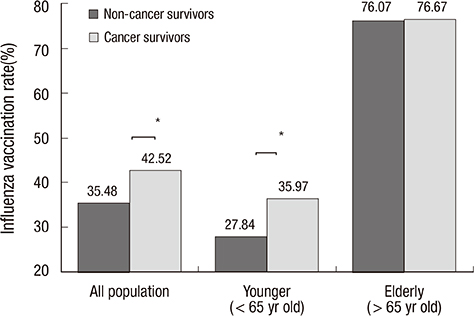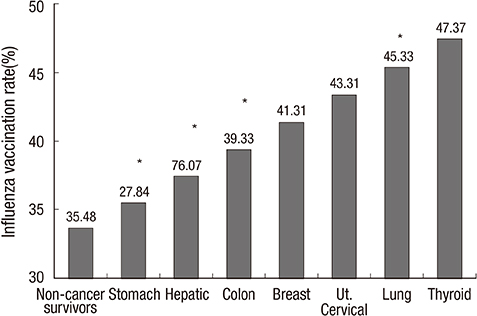J Korean Med Sci.
2014 Aug;29(8):1061-1068. 10.3346/jkms.2014.29.8.1061.
Influenza Vaccination and Associated Factors among Korean Cancer Survivors : A Cross-Sectional Analysis of the Fourth & Fifth Korea National Health and Nutrition Examination Surveys
- Affiliations
-
- 1Center for Health Promotion & Cancer Prevention, Dongnam Institute of Radiological & Medical Sciences, Busan, Korea.
- 2Department of Family Medicine, Seoul National University Hospital, Seoul National University College of Medicine, Seoul, Korea. smpark.snuh@gmail.com
- 3JW LEE Center for Global Medicine and Department of Family Medicine, Seoul National University College of Medicine and Seoul National University Bundang Hospital, Seongnam, Korea.
- 4Department of Family Medicine, National Police Hospital, Seoul, Korea.
- 5Department of Family Medicine, Dong-A University College of Medicine, Busan, Korea.
- KMID: 2129599
- DOI: http://doi.org/10.3346/jkms.2014.29.8.1061
Abstract
- Influenza vaccination is important for cancer survivors, a population with impaired immunity. This study was designed to assess influenza vaccination patterns among Korean cancer survivors. In this cross-sectional analysis, data were obtained from standardized questionnaires from 943 cancer survivors and 41,233 non-cancer survivors who participated in the Fourth and Fifth Korea National Health and Nutrition Examination Surveys (2007-2011). We identified the adjusted influenza vaccination rates and assessed factors associated with influenza vaccination using multivariate logistic regression. Cancer survivors tended to have a higher adjusted influenza vaccination rate than the general population. The rates for influenza vaccination in specific cancer types such as stomach, hepatic, colon, and lung cancers were significantly higher than non-cancer survivors. Among all cancer survivors, those with chronic diseases, elderly subjects, and rural dwellers were more likely to receive influenza vaccination; those with cervical cancer were less likely to receive influenza vaccination. Cancer survivors were more likely to receive influenza vaccinations than non-cancer survivors, but this was not true for particular groups, especially younger cancer survivors. Cancer survivors represent a sharply growing population; therefore, immunization against influenza among cancer survivors should be concerned as their significant preventative healthcare services.
Keyword
MeSH Terms
-
Adult
Age Distribution
Aged
Aged, 80 and over
Comorbidity
Disease Susceptibility/mortality
Educational Status
Female
Health Behavior
Humans
Influenza Vaccines/*therapeutic use
Influenza, Human/*mortality/*prevention & control
Male
Mass Vaccination/*utilization
Middle Aged
Neoplasms/*mortality
Republic of Korea/epidemiology
Risk Factors
Sex Distribution
Social Class
Survival Rate
Survivors/*statistics & numerical data
Influenza Vaccines
Figure
Reference
-
1. Jung KW, Park S, Kong HJ, Won YJ, Lee JY, Park EC, Lee JS. Cancer statistics in Korea: incidence, mortality, survival, and prevalence in 2008. Cancer Res Treat. 2011; 43:1–11.2. Siegel R, Naishadham D, Jemal A. Cancer statistics, 2012. CA Cancer J Clin. 2012; 62:10–29.3. National Cancer Information Center. Cancer incidence. accessed on 1 November 2012. Available at http://www.cancer.go.kr/ncic/cics_f/01/011/index.html.4. Cooksley CD, Avritscher EB, Bekele BN, Rolston KV, Geraci JM, Elting LS. Epidemiology and outcomes of serious influenza-related infections in the cancer population. Cancer. 2005; 104:618–628.5. Prevention and control of influenza: recommendations of the Advisory Committee on Immunization Practices (ACIP): Centers for Disease Control and Prevention. MMWR Recomm Rep. 1996; 45:1–24.6. Kim HS, Kim JH, Shin SY, Kang YA, Lee HG, Kim JS, Lee JK, Cho B. Fatal cases of 2009 pandemic influenza A (H1N1) in Korea. J Korean Med Sci. 2011; 26:22–27.7. Baek JH, Seo YB, Choi WS, Kee SY, Jeong HW, Lee HY, Eun BW, Choo EJ, Lee J, Kim SR, et al. Guideline on the prevention and control of seasonal influenza in healthcare setting. Korean J Intern Med. 2014; 29:265–280.8. Wingard JR. Influenza: preparedness for an inevitable "Emergency" for oncology and BMT units. J Natl Compr Canc Netw. 2008; 6:215–222.9. Avritscher EB, Cooksley CD, Geraci JM, Bekele BN, Cantor SB, Rolston KV, Elting LS. Cost-effectiveness of influenza vaccination in working-age cancer patients. Cancer. 2007; 109:2357–2364.10. Kunisaki KM, Janoff EN. Influenza in immunosuppressed populations: a review of infection frequency, morbidity, mortality, and vaccine responses. Lancet Infect Dis. 2009; 9:493–504.11. Rodrigues RS, Marchiori E, Bozza FA, Pitrowsky MT, Velasco E, Soares M, Salluh JI. Chest computed tomography findings in severe influenza pneumonia occurring in neutropenic cancer patients. Clinics (Sao Paulo). 2012; 67:313–318.12. Fiore AE, Shay DK, Broder K, Iskander JK, Uyeki TM, Mootrey G, Bresee JS, Cox NJ. Centers for Disease Control and Prevention. Prevention and control of seasonal influenza with vaccines: recommendations of the Advisory Committee on Immunization Practices (ACIP), 2009. MMWR Recomm Rep. 2009; 58:1–52.13. Snyder CF, Frick KD, Peairs KS, Kantsiper ME, Herbert RJ, Blackford AL, Wolff AC, Earle CC. Comparing care for breast cancer survivors to non-cancer controls: a five-year longitudinal study. J Gen Intern Med. 2009; 24:469–474.14. Nordøy T, Aaberge IS, Husebekk A, Samdal HH, Steinert S, Melby H, Kolstad A. Cancer patients undergoing chemotherapy show adequate serological response to vaccinations against influenza virus and Streptococcus pneumoniae. Med Oncol. 2002; 19:71–78.15. Ring A, Marx G, Steer C, Prendiville J, Ellis P. Poor uptake of influenza vaccinations in patients receiving cytotoxic chemotherapy. Int J Clin Pract. 2003; 57:542–543.16. Shih YC, Pan IW. Influenza vaccination among individuals with cancer and their family members. Am J Prev Med. 2010; 38:61–69.17. Shin DW, Kim Y, Park JH, Cho J, Jho HJ, Yang HK, Kim HS, Kim SY. Practices and predictors of 2009 H1N1 vaccination in cancer patients: a nationwide survey in Korea. Influenza Other Respir Viruses. 2012; 6:e120–e128.18. Ganry O, Baudoin C, Fardellone P. Effect of alcohol intake on bone mineral density in elderly women: the EPIDOS Study: Epidémiologie de l'Ostéoporose. Am J Epidemiol. 2000; 151:773–780.19. Han MA, Kim KS, Park J, Kang MG, Ryu SY. Association between levels of physical activity and poor self-rated health in Korean adults: the Third Korea National Health and Nutrition Examination Survey (KNHANES), 2005. Public Health. 2009; 123:665–669.20. Nagata JM, Hernández-Ramos I, Kurup AS, Albrecht D, Vivas-Torrealba C, Franco-Paredes C. Social determinants of health and seasonal influenza vaccination in adults ≥65 years: a systematic review of qualitative and quantitative data. BMC Public Health. 2013; 13:388.21. Armstrong K, Berlin M, Schwartz JS, Propert K, Ubel PA. Barriers to influenza immunization in a low-income urban population. Am J Prev Med. 2001; 20:21–25.22. Fairley TL, Hawk H, Pierre S. Health behaviors and quality of life of cancer survivors in Massachusetts, 2006: data use for comprehensive cancer control. Prev Chronic Dis. 2010; 7:A09.23. Kwong JC, Rosella LC, Johansen H. Trends in influenza vaccination in Canada, 1996/1997 to 2005. Health Rep. 2007; 18:9–19.24. Baldwin LM, Dobie SA, Cai Y, Saver BG, Green PK, Wang CY. Receipt of general medical care by colorectal cancer patients: a longitudinal study. J Am Board Fam Med. 2011; 24:57–68.25. Underwood JM, Townsend JS, Stewart SL, Buchannan N, Ekwueme DU, Hawkins NA, Li J, Peaker B, Pollack LA, Richards TB, et al. Surveillance of demographic characteristics and health behaviors among adult cancer survivors: Behavioral Risk Factor Surveillance System, United States, 2009. MMWR Surveill Summ. 2012; 61:1–23.26. Chin-Yee BH, Monkman K, Hussain Z, Minuk LA. Attitudes toward vaccination for pandemic H1N1 and seasonal influenza in patients with hematologic malignancies. J Support Oncol. 2011; 9:156–160.27. Loulergue P, Mir O, Alexandre J, Ropert S, Goldwasser F, Launay O. Low influenza vaccination rate among patients receiving chemotherapy for cancer. Ann Oncol. 2008; 19:1658.28. Sommer AL, Wachel BK, Smith JA. Evaluation of vaccine dosing in patients with solid tumors receiving myelosuppressive chemotherapy. J Oncol Pharm Pract. 2006; 12:143–154.29. Snyder CF, Frick KD, Herbert RJ, Blackford AL, Neville BA, Carducci MA, Earle CC. Preventive care in prostate cancer patients: following diagnosis and for five-year survivors. J Cancer Surviv. 2011; 5:283–291.30. Snyder CF, Earle CC, Herbert RJ, Neville BA, Blackford AL, Frick KD. Trends in follow-up and preventive care for colorectal cancer survivors. J Gen Intern Med. 2008; 23:254–259.31. Australian Government Department of Health. accessed on 1 September 2013. Avaliable at http://www.health.gov.au/internet/immunise/publishing.nsf/Content/immunise-influenza.32. Snyder CF, Earle CC, Herbert RJ, Neville BA, Blackford AL, Frick KD. Preventive care for colorectal cancer survivors: a 5-year longitudinal study. J Clin Oncol. 2008; 26:1073–1079.33. Takayama M, Wetmore CM, Mokdad AH. Characteristics associated with the uptake of influenza vaccination among adults in the United States. Prev Med. 2012; 54:358–362.34. Vander Weg MW, Howren MB, Cai X. Use of routine clinical preventive services among daily smokers, non-daily smokers, former smokers, and never-smokers. Nicotine Tob Res. 2012; 14:123–130.35. La Torre G, Iarocci G, Cadeddu C, Boccia A. Influence of sociodemographic inequalities and chronic conditions on influenza vaccination coverage in Italy: results from a survey in the general population. Public Health. 2010; 124:690–697.36. Suh B, Shin DW, Kim SY, Park JH, Chang WY, Lim SP, Yim CY, Cho BL, Park EC, Park JH. Mode of primary cancer detection as an indicator of screening practice for second primary cancer in cancer survivors: a nationwide survey in Korea. BMC Cancer. 2012; 12:557.37. Van der Aa MA, Siesling S, Louwman MW, Visser O, Pukkala E, Coebergh JW. Geographical relationships between sociodemographic factors and incidence of cervical cancer in the Netherlands 1989-2003. Eur J Cancer Prev. 2008; 17:453–459.38. Souza TM, Salluh JI, Bozza FA, Mesquita M, Soares M, Motta FC, Pitrowsky MT, de Lourdes, Mishin VP, Gubareva LV, et al. H1N1pdm influenza infection in hospitalized cancer patients: clinical evolution and viral analysis. PLoS One. 2010; 5:e14158.39. Kwong EW, Lam IO, Chan TM. What factors affect influenza vaccine uptake among community-dwelling older Chinese people in Hong Kong general outpatient clinics? J Clin Nurs. 2009; 18:960–971.40. Arrowood JR, Hayney MS. Immunization recommendations for adults with cancer. Ann Pharmacother. 2002; 36:1219–1229.
- Full Text Links
- Actions
-
Cited
- CITED
-
- Close
- Share
- Similar articles
-
- Psychological Status and Associated Factors among Korean Cancer Survivors: a Cross-Sectional Analysis of the Fourth & Fifth Korea National Health and Nutrition Examination Surveys
- The Correlates of Influenza Vaccination among Korean Elderly Men and Women
- Trends in Influenza Vaccination Coverage Rates among Korean Cancer Survivors: Analysis of the Korea National Health and Nutrition Examination Survey III–VI
- Association between Living Arrangements and Influenza Vaccination Rates among Elderly South Korean People: The Fifth Korea National Health and Nutrition Examination Survey (KNHANES V-2)
- Influenza Vaccination Coverage Rate according to the Pulmonary Function of Korean Adults Aged 40 Years and Over: Analysis of the Fifth Korean National Health and Nutrition Examination Survey



